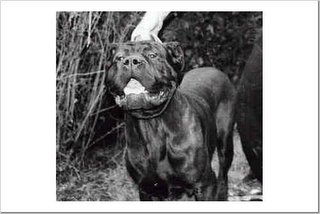The Bandog Mastiff
~Dr. Caius 16th Century
General: The bandog is designed to be a close quarter combat dog. It excels in realistic protection and can be a wonderful companion/family dog for experienced dog owners. They are quite trainable and easy to maintain. It is naturally good natured, fond of children in general, extremely devoted to its owner and eager to work. Appearance is muscular, behavior is self assured, steady and fearless. It is basically a calm dog that transforms when a bad situation arises.
History: The Bandog philosophy of breeding has existed just about as long as domestic dogs themselves. Mankind developed fleet, nimble hunting dogs that fulfill the purposes of the hunter-gatherers, through to the large breeds that guard settlements and livestock. The progression toward breeding these heavier dogs to the smaller, more athletic dogs producing a medium type has been a natural process that has independantly occurred across several geographic regions. The resultant dogs proving to be more flexible across a greater variety of tasks. Bandogs have been used primarily for big game hunting and as guard dogs throughout the centuries. The first most organized and well documented approach and application of the Bandog was done by British "Gamekeepers" whose "Gamekeepers Night Dog" fulfilled the role of patrol companion and 'despatch dog' (capturing wounded game so they could be dispatched without undue suffering). The Gamekeepers Night Dog had an extremely dangerous job that often cost it its life. It had to locate and fight armed "Poachers" who would often find themselves fighting these dogs for their lives. In the 1820's, the "caught" poacher could see one shipped off to the colonies of Australia or America, if they were lucky, such punishments however, made desperate men. In France, similar types were bred to partake similar roles, the paralells even extending to nomenclature: Chien du Nuit...
~Written by Dan Balderson of England and Stelios Sdrolias of Greece
Stelios Sdrolias Bandogs http://www.bandog.gr
info@bandog.grOriginally posted at http://www.pulldoggies.com/bandog.htm

